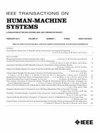对外部重复扰动的响应随时间间隔而变化
IF 4.4
3区 计算机科学
Q2 COMPUTER SCIENCE, ARTIFICIAL INTELLIGENCE
引用次数: 0
摘要
一般认为,不同时间间隔的刺激会导致相关学习底物的不同贡献。我们研究了男性对不同时间间隔的扰动序列的姿势反应。共有 12 名无神经障碍的男性志愿者(年龄:33.33±3.12 S.D.)经历了一连串的扰动。我们设计并实施了两个由平移板沿前后方向对静止参与者进行扰动的序列:第一个序列由 24 次重复扰动组成,每次间隔 5 秒钟;第二个序列由每次间隔 2.5 秒钟的扰动组成。我们发现,虽然较短的间隔和较长的间隔都会导致学习效果(P < 0.05),但较短的间隔会导致一种僵硬的策略,可能是通过肌肉共收缩,将身体摇摆的程度降到最低。在经历捕捉试验后,学习到的运动反应仍在继续(P < 0.05)。这些结果表明,在恢复姿势稳定性的过程中,刺激间隔可能会导致神经运动系统产生不同的适应机制。此外,我们的结果还表明,以较短的时间间隔对男性个体进行重复姿势扰动训练,会导致更大程度的僵硬策略。僵硬策略可能会降低应对意外姿势威胁的能力,从而可能导致跌倒。本文章由计算机程序翻译,如有差异,请以英文原文为准。
Responses to External Repeated Perturbations Vary With Time Intervals
It is generally accepted that stimuli with different time intervals lead to different contributions of relevant learning substrates. We investigated postural responses in men to trains of perturbations with different time intervals. A total of 12 male volunteers with no neurological deficits (age: 33.33±3.12 S.D.) experienced a sequence of perturbations. Two sequences of perturbations by a translational plate to still standing participants in the anterior-posterior direction were designed and administered: the first sequence consisted of 24 repeated perturbations with an interval of 5 s, while the second sequence consisted of ones with an interval of 2.5 s. A perturbation of a smaller magnitude was inserted into each sequence as a catch trial. We found that while a shorter interval and a longer interval both led to the learning effect (P < 0.05), a shorter interval results in a stiff strategy, presumably through muscle cocontraction, minimizing the degree of body sway. The learned motor response continued after experiencing the catch trial (P < 0.05). The results imply that stimulus intervals could lead to a different adaptation mechanism in the neuromotor system in the way to regain postural stability. Also, our results suggest that training for male individuals with repetition of postural perturbations with a shorter time interval leads to a stiff strategy with a greater degree. A stiff strategy could lower the ability to cope with unexpected postural threats, possibly leading to falls.
求助全文
通过发布文献求助,成功后即可免费获取论文全文。
去求助
来源期刊

IEEE Transactions on Human-Machine Systems
COMPUTER SCIENCE, ARTIFICIAL INTELLIGENCE-COMPUTER SCIENCE, CYBERNETICS
CiteScore
7.10
自引率
11.10%
发文量
136
期刊介绍:
The scope of the IEEE Transactions on Human-Machine Systems includes the fields of human machine systems. It covers human systems and human organizational interactions including cognitive ergonomics, system test and evaluation, and human information processing concerns in systems and organizations.
 求助内容:
求助内容: 应助结果提醒方式:
应助结果提醒方式:


